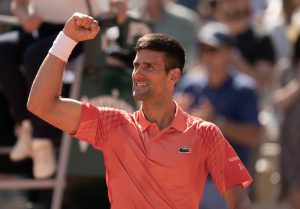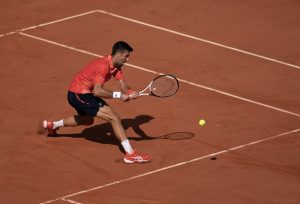Ahead of the ATP Cup next week, Martin Keady, our resident tennis historian, takes a look at the history of international team tennis tournaments, from the Grandaddy of them all – The Davis Cup – to the newest arrivals, like the ATP Cup itself.
Tennis may be the greatest individual sport, but it also has a long history of team events, especially international team events that pit the finest players from one country against those of another. Ahead of the ATP Cup in Australia next week, here’s a look back at the other major international team tennis tournaments – and a look forward to what might yet be the future of international team tennis.
The Davis Cup
The Davis Cup is the Grandaddy of all other international team tennis events. It was named after Dwight F. (for Filley, no less!) Davis, a keen American tennis player and fan who later became a renowned politician. International competition in tennis already existed by the end of the 19th century, as the sport became more popular around the world and especially in Europe and America. However, when the idea emerged of codifying the competition between Britain and America, which at the time were the twin tennis superpowers, it was named after the wealthy Davis, in the hope that he would provide a prize of some kind. As a tennis lover, Davis was happy to oblige and thus the premier international team tennis tournament began in 1900. Initially, it was just played between Britain and America, but over time other countries were allowed to enter, especially as American tennis began to assert its dominance over its British equivalent, and gradually the Davis Cup became a genuinely international event.
Over the 121-year history of the Davis Cup, it is possible to identify three distinct major phases during which the tournament changed considerably. The first was the second half of the 1920s, when Frances’s “Mousquetaires” – Jean Borotra, Jacques Brugnon, Henri Cochet and René Lacoste – first broke the US stranglehold over the competition and then asserted their own, winning six Davis Cups in a row between 1927 and 1932. In the process, they four-handedly helped to popularise tennis in France to the extent that nearly a hundred years later France still has the highest number of tennis players (amateur and professional) per capita of any country in the world.
The second major phase in the history of the Davis Cup was the great post-war struggle between America and the newest superpower in tennis, Australia. Incredibly, between 1946 and 1973 they were the only winners of the tournament, and perhaps even more remarkably between 1946 and 1959 they were the only two teams to reach the final.
Finally, the third major phase in the evolution of the Davis Cup was the last before the tournament was officially revamped (and many would say ruined) in 2019. From the start of the Open era in 1968 onwards, the demands on the top male players eventually became so great that by the start of the 21st century the Davis Cup had unfortunately become almost an afterthought. There was a resurgence of sorts in the last decade, as the “Big Three” of Federer, Nadal and Djokovic all competed in, and won, the Davis Cup for their countries, but alas rarely at the same time. Consequently, in 2019 the tournament abandoned its century-old format of being played throughout the year and was instead played in one week, in Madrid. Unsurprisingly, Spain – the newest superpower of tennis – won, and the fear remains that so long as the tournament is only played in Spain other countries will struggle to win it.
The Fed Cup – now The Billie Jean King Cup
Tennis has always been proud of the fact that from the very start both men and women have played it and that there has always been great interest in both men’s and women’s tennis, which is still reflected in the fact that almost all of the highest-earning sportswomen in the world are tennis players. Thus it is all the more surprising that it was more than 60 years before a women’s equivalent of the Davis Cup was created. There was the Wightman Cup, which was played, as the Davis Cup was originally, between US and British players, but it was only in 1963 that the Fed (short for Federations) Cup finally provided a genuine female equivalent of the Davis Cup.
The first Fed Cup Finalists were the USA and Australia, who in the post-war period were as far ahead of other nations in women’s tennis as they were in the men’s game. Indeed, those two countries contested the first three Fed Cup Finals (the US winning the first and Australia winning the next two). Gradually, however, as tennis became more truly global, particularly with the introduction of professionalism in 1968, other countries began to compete for the crown.
In particular Czechoslovakia, which is now the Czech Republic, began to emerge as a genuine third force in women’s international team tennis. They first won the Fed Cup in 1975, with Martina Navratilova on the team, but even after Navratilova defected to the US the Czechs remained a formidable outfit, with younger players, particularly Hana Mandlíková, replacing her. However, it was only in the early 21st century that the newly created Czech Republic became the dominant force in women’s tennis, replacing the older powers of America and Australia, winning six Fed Cups between 2011 and 2019, with Jana Kvitova and Lucie Šafářová among their mainstays.
Finally, in 2020, the Fed Cup was no more, as it was officially renamed the Billie Jean King Cup, in recognition of the seminal role that the great American had played in the formation of the Women’s Tennis Association and the true globalisation of women’s tennis. Despite the name change, however, the “women’s Davis Cup” has remained a poor relation of the men’s tournament, with continuing uncertainty over when, or even if, it will be played in 2021, as the global Covidemic continues to wreak havoc with the scheduling plans of tennis and indeed all sports.
The Laver Cup
Rod Laver is rightly regarded as one of the greatest male tennis players ever, if not the very best, not least because he was prevented from playing at the Majors during the prime of his career, having turned professional after winning the fabled Grand Slam – winning all four Majors in one calendar year – in 1962. It was only when tennis finally became fully and openly professional that he was able to return to the Majors and he quickly made up for lost time, winning yet another Grand Slam in 1969. Nevertheless, it is questionable whether the tournament that bears his name is the best way of commemorating his extraordinary contribution to the history of men’s tennis.
The Laver Cup was first played in 2017, with one of the oddest formats in all of international sport, let alone tennis. Reflecting the current dominance of continental Europe, from which all three of the current “Big Three” hail, the Laver Cup pits a Europe team against a team from the Rest of the World. It is not certain that this format will remain in the future, especially if the sport’s centre of gravity moves away from Europe again. Indeed, I have previously speculated that a longer-term format for the Laver Cup might be as an intercontinental tournament, not just pitting one continent (Europe) against the rest of the world, but every continent against every other continent, with, say, North America playing South America, and Europe playing Australasia. The only downside of such a format is that it would only emphasise the glaring lack of African tennis (South African tennis excepted), but hopefully that is something else that can change as the 21st century progresses.
[pickup_prop id=”4647″]
The ATP Cup
The newest kid on the block is, of course, the ATP Cup, the second edition of which will take place in Australia next week. The first edition took place more than a year ago, in early January 2020, against the backdrop of the Australian bushfires that everyone thought would be the environmental story of the year until the coronavirus pandemic struck. Nevertheless, it was considered a success, not least because by taking place at the start of the season rather than the end (like the revamped Davis Cup), it capitalised upon both the players’ freshness and their desire for competitive tennis before the first Major of the year, the Australian Open.
Most importantly, of course, the tennis played at the event was of an extremely high level, with Novak Djokovic’s Serbia eventually prevailing over Rafael Nadal’s Spain in the Final. However, perhaps the real star of the tournament was the second-best male Serbian player, Dušan Lajović, who may just have played the best tennis of his career to become an incredibly effective wingman to Djokovic.
The second ATP Cup, which starts next Tuesday (2 February), will be a very different beast to the original, largely as a result of the coronavirus and the ultra-strict quarantining that Australia has insisted every foreign tennis player must complete before being allowed to compete in either the ATP Cup or the Australian Open itself. So, the 2021 ATP Cup will be competed for by only 12 nations rather than the 20 that took part last year, it will last half as long as the 2020 version (taking place over five days rather than 10) and it will only be played in Melbourne, rather than being spread out throughout other Australian cities, as was the case last year.
Nevertheless, the real challenge for the ATP Cup in the long term is not the coronavirus (daunting as that is) but the competition with the revamped Davis Cup. In January last year, at the conclusion of the first ATP Cup, almost everyone involved, including Rafael Nadal, said that it was obvious that there was only room in the tennis calendar for one premier men’s international team tournament. So, over the next few years, the ATP Cup and the newly rebranded Davis Cup will surely compete against each other for resources and perhaps even more importantly publicity, as each one attempts to prove that it should be the only major international team event for male players.
And finally – a future Tennis World Cup?
Finally, we come to the elephant that isn’t even in the room – a true Tennis World Cup, played once every four years and perhaps involving both the best men and the best women from each nation. As I have written before for LWOT, it seems extraordinary that such an obvious money-spinning and eyeball-grabbing event, a World Cup that would be second only to the original World Cup (in football) in its genuinely global reach and interest, has never seriously been discussed. At the moment, of course, any attempt even to discuss it is off the table, as the sport attempts to regain momentum after the pandemic-disrupted 2020. Nevertheless, in the future surely a modern-day Dwight F. Davis will emerge to propose and even organise such a tournament. However, there will be no need to name it after them, because “The Tennis World Cup” will be all the title it needs.
Main Photo:






